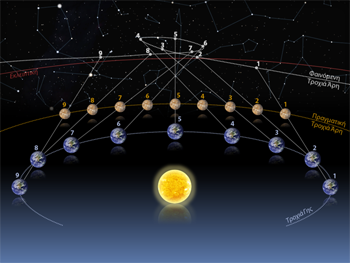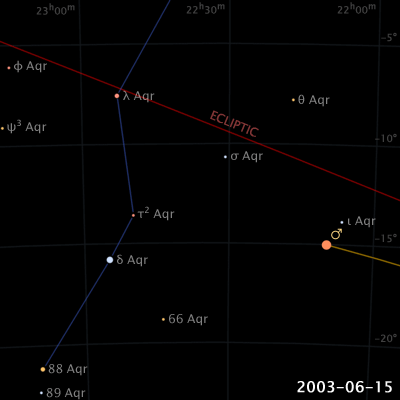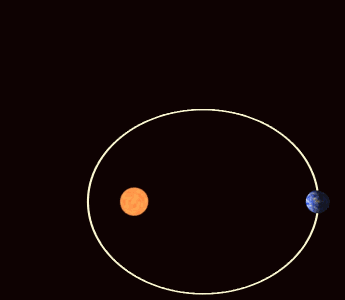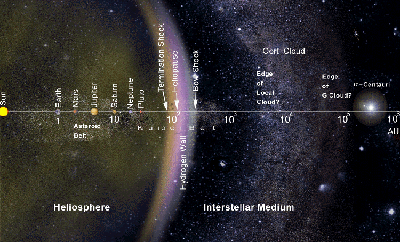COSMIC SECRETS, PART 6
THE RETROGRADE AND PRECESSION MOTIONS OF PLANETS
This page examines two previously unexplained Solar System anomalies. They are known as (1) the retrograde orbital motion of planets and (2) the precession orbital motion of planets.
The Orbital Retrograde Phenomenon
The normal orbit of planets around the Sun is in a counterclockwise manner. Occasionally, in their orbits, astronomers have observed that planets tend to reverse course and briefly start moving around or orbiting the Sun in a clockwise manner. This brief reversal of orbital motion is referred to as a retrograde orbit. How can this be? What accounts for this retrograde motion of planets?
For many centuries, this revelation about brief planetary retrograde motion puzzled scientists. Scientists could not explain how the planets seemed to briefly start orbiting the Sun in a clockwise manner before changing course by resuming their normal counterclockwise orbits.
To be sure, if it were proven to be a fact, then the retrograde motions of planets would represent a fundamental violation of Sir Isaac Newton's laws of motion. According to Sir Isaac Newton, a (heavenly) body in motion would stay in motion. A (heavenly) body in motion would not change its path of motion unless it was acted upon by an unbalanced force. Yet, other than the gravitational force of the Sun, no unbalanced force was observed acting on the planets such that, during the course of their orbits around the Sun, the planets would suddenly and momentarily change course and start orbiting around the Sun in the opposite direction before resuming their counterclockwise orbits. What, then, was going on with the planets to explain their observed occasional retrograde motions?

Retrograde Motion of Mars

Apparent Retrograde Motion of the Planet Mars
It turns out that the answer to this cosmic secret is this: The seemingly retrograde motion of planets is nothing other than an optical illusion much like the rising and setting of the Sun are optical illusions. Except in its orbit around the center of the Milky Way galaxy and except for the entire Milky Way galaxy floating through spacetime, the Sun's position is fixed. That is to say, the Sun never moves relative to the positions of the planets in the Solar System. It is the planets that are moving. It is the planets that are orbiting around the Sun as they revolve on their axes. It is the revolution and orbit of planets that create the optional illusion of planetary retrograde motions as planets overtake one another while orbiting the Sun. Likewise, it is the rotating of Earth on its axis and the revolving of Earth around the Sun that create the optical illusion of a rising and setting Sun.
The next bloc of videos provides additional insights into the retrograde motion of planets.
The Orbital Precession Phenomenon
Another observed but once little understood Solar System phenomenon was the unusual orbit of the planet Mercury. Astronomers long ago had observed that the planets follow precise or fixed, counterclockwise, and elliptical orbits around the Sun. One exception to this fixed-orbit rule was the case of planet Mercury. After years of observation, astronomers observed that Mercury was minutely shifting position in its orbit of the Sun. Mercury orbit's of the Sun was not as fixed as were the orbits of the other planets in the Solar System. The shifting position of a planet's orbit of the Sun is referred to as orbital precession. Scientists observed the unusual degree to which Mercury's orbit was shifting, but they were not able to reconcile their observed measurements to the measurements provided by using Sir Isaac Newton's laws of motion and universal gravitation.
For instance, scientists observed Mercury's orbital shift to be by an amount of, say, y degrees over time. But, in their calculations, they only could account for, say x degrees in the amount of Mercury's orbital shift. What accounted for the difference between observed y degrees but computed x degrees? What was happening to cause Mercury to possess a noticeably precessed orbit in the first place? What accounted for the inconsistency in the observed precession versus the mathematical calculations of that same precession?

Precessing Kepler Orbit
Centuries had passed since Mercury's precessed orbit was observed, but scientists were not able to explain this orbital anomaly. It was for the great Albert Einstein to provide a definitive answer to Mercury's precessed orbit. Albert Einstein applied his theory of relativity to Mercury's orbit of the Sun to provide an answer to this cosmic secret.

Albert Einstein
Through mathematical calculations, Albert Einstein explained that Mercury's shifting orbit was caused by the more intensive gravitational effects of warped spacetime around Mercury. This more intensively warped spacetime around Mercury was due to Mercury's very close proximity to the massive Sun, which, in turn, caused Mercury's orbit to precess at a significantly greater degree relative to that of the other planets in the Solar System. Precessed orbits have been observed for the other planets, too, but the degree of their precession over time is negligble or not nearly as dramatic as Mercury's precession over time as explained and illustrated here.
The next bloc of videos provides additional insights into planetary orbital precession, in general, and the planet Mercury with its unusually precessed orbit, in particular.
MORAL OF THE STORY
What is the moral of this retrograde and precession story? The moral of the story is this: When it comes to unexplained phenomena in life (such as planetary orbital anomalies, for instance), do not allow your beliefs to be driven by superstitious, outlandish, and ridiculous claims about reality. Instead, follow the evidence. Often in life, when an unexplained phenomenon is studied persistently, carefully, and methodically, then it turns out that a perfectly logical explanations exist for seemingly inexplicable phenomena.

Scale of the Heliosphere and Nearby Galactic Neighborhood
| Count | Name of Heavenly Body | Average Distance from Sun (As Kilometers) | Average Distance from Sun (As Miles) | Amount of Time for Light to Reach from Sun (As Minutes) | Number of Astronomical Units (AU) from Sun |
|---|---|---|---|---|---|
| Count | Name of Heavenly Body | Average Distance from Sun (As Kilometers) | Average Distance from Sun (As Miles) | Amount of Time for Light to Reach from Sun (As Minutes) | Number of Astronomical Units (AU) from Sun |
| 1 | Mercury | 57,900,000 | 36,000,000 | 3 | 0.39 |
| 2 | Venus | 108,200,000 | 67,200,000 | 6 | 0.72 |
| 3 | Earth | 149,600,000 | 93,000,000 | 8 | 1.00 |
| 4 | Mars | 227,900,000 | 141,600,000 | 13 | 1.52 |
| 5 | Jupiter | 778,600,000 | 483,800,000 | 43 | 5.20 |
| 6 | Saturn | 1,433,500,000 | 890,800,000 | 80 | 9.58 |
| 7 | Uranus | 2,872,500,000 | 1,784,800,000 | 160 | 19.20 |
| 8 | Neptune | 4,495,100,000 | 2,793,100,000 | 250 | 30.05 |
| 9 | Pluto | 5,906,400,000 | 3,670,000,000 | 328 | 39.48 |
| 10 | Proxima Centauri | 39,707,871,077,952 (trillion) |
24,673,327,418,880 (trillion) |
2,207,520 (or 4.2 years) |
265,426.95 |

Geostationary Satellite
FOR UNLAWFUL CARNAL KNOWLEDGE...IN THE MOOD
Okay, that's enough talk about planets, orbits, the Sun, and the Universe for now. In closing, it is time to return home to Earth. How about it one time for a little bit of Earth-style—and, in particular, USA-style—carnal knowledge to celebrate the return home? It is time for some unlawful carnal knowledge. After all, as insinuated by Ariana Grande, 34 + 35=69—or, mealtime.
I wonder what professor Einstein would say if he saw this next bloc of music videos. (Caution: While, in my opinion, the music videos below are suitable for teenagers, at times, they can be somewhat steamy, profane, and suggestive. The music videos below strictly are intended for adult enjoyment. If mild or tame depictions of human carnal situations upset or offend you, or if you feel that such videos are not suitable or appropriate for viewing, then please do not watch the videos.)
Ladies Shout to the Fellas
Fellas Holler Back at the Ladies
Ladies and Fellas Mixing It Up
Feeling Ecstatic
I would like to think that professor Einstein would not recoil in horror after viewing the above bloc of music videos. Instead, I would prefer to think that professor Einstein would exclaim, "What's It Gonna Be?!" LOL.😋
On a more serious note, as I noted on the "H.A.B.C." page of this website, I am cognizant of the human preoccupation with copulation, particularly, among the young adults who have moved beyond puberty and into the young adulthood stage of life. Their hormones are raging. The human obsession with copulation is a natural, rational, and sometimes addictive instinct. The act of copulating plays a vital survival-of-the-species role on Earth, which is the procreation and propagation of life into the next generation. Do some humans get carried away with copulation? Do some humans take copulation to the extremes? Obviously (given the tremendous volume and variety of pornography available on the World Wide Web), the answer to both questions is, "yes." Should humans take copulation to the extremes? The answer is, "probably not."
😄
FLATTER THIS SITE:

SEARCH THIS SITE:
Intellectual Property Disclosures: All videos and songs (as well as many of the images) referenced or spotlighted throughout this website are the legal and intellectual properties of others. All content and opinions on this website (bruessard.com) are those of the author (Edward Bruessard) exclusively and do not necessarily reflect the opinions of the contributors, creators, owners, and distributors of these referenced videos, songs, and images. The author holds no legal interest or financial stake in any of these referenced videos, songs, and images. The contributors, creators, owners, and distributors of these referenced videos, songs, and images played no role at all regarding the appearance of said videos, songs, and images throughout this website; they had no clue that this website would be spotlighting their works.


